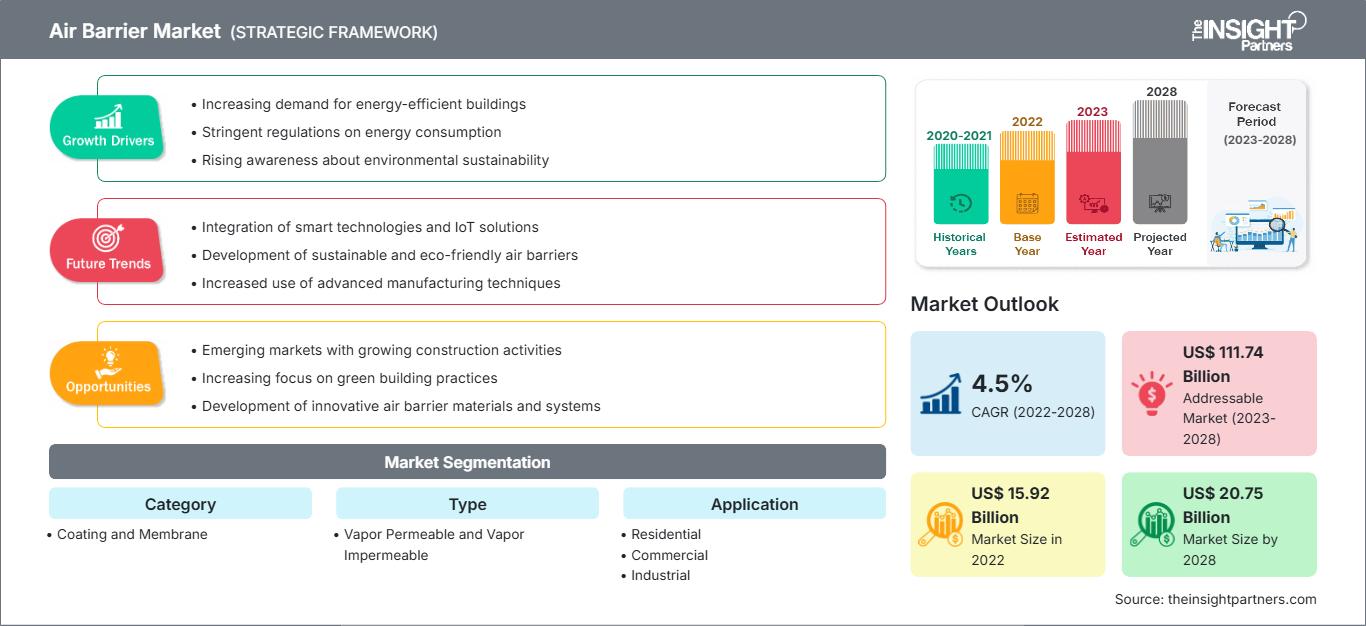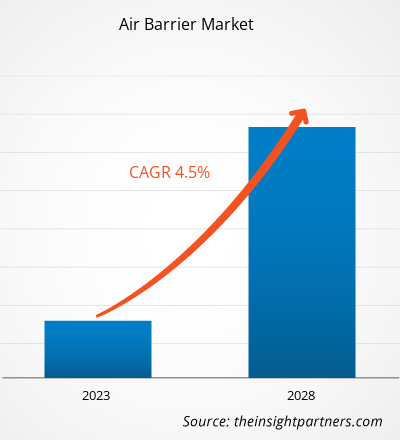[Rapporto di ricerca]Il mercato delle barriere d'aria è stato valutato a 15.924,68 milioni di dollari nel 2022; si prevede una crescita a un CAGR del 4,5% dal 2022 al 2028.
Le barriere d'aria sono materiali utilizzati per controllare il flusso d'aria nelle chiusure degli edifici. Questi sistemi racchiudono completamente l'aria all'interno di un edificio. Le proprietà fisiche che distinguono le barriere d'aria dagli altri materiali sono la capacità di resistere al flusso d'aria e alla pressione. Le barriere d'aria possono essere posizionate in qualsiasi punto dell'involucro edilizio, sulla superficie esterna, interna o in qualsiasi punto intermedio. Le barriere d'aria interne in climi caldi aiutano a controllare l'esfiltrazione dell'aria interna, mentre le barriere d'aria esterne controllano l'infiltrazione dell'aria esterna e prevengono il dilavamento del vento attraverso l'isolamento.
Impatto della pandemia di COVID-19 sul mercato delle barriere d'aria
Prima della pandemia di COVID-19, il mercato delle barriere d'aria in tutto il mondo era trainato principalmente dal loro crescente utilizzo nei settori dell'edilizia residenziale, commerciale e industriale. Tuttavia, nel 2020, diversi settori hanno dovuto rallentare le proprie attività a causa delle interruzioni nelle catene del valore causate dalla chiusura dei confini nazionali e internazionali. La pandemia di COVID-19 ha avuto un impatto negativo sulle economie e sui settori a causa di lockdown, divieti di viaggio e chiusure aziendali. La pandemia di COVID-19 ha causato interruzioni della catena di approvvigionamento di materie prime chiave e ha ostacolato i processi produttivi a causa delle restrizioni imposte dalle autorità governative. La pandemia di COVID-19 ha avuto un impatto senza precedenti sul settore edile, incidendo negativamente sulla crescita del mercato delle barriere d'aria. Inoltre, i materiali necessari nel settore edile hanno subito un'inflazione dovuta all'interruzione della catena di approvvigionamento, all'aumento dei costi di manodopera e all'elevata domanda.
Tuttavia, il mercato si sta riprendendo grazie alle misure significative adottate dai governi di diversi paesi. Il settore edile sta inoltre superando le sfide legate all'interruzione della catena di approvvigionamento delle materie prime. La ripresa delle attività di costruzione a livello globale ha generato una domanda di barriere d'aria.
Personalizza questo rapporto in base alle tue esigenze
Potrai personalizzare gratuitamente qualsiasi rapporto, comprese parti di questo rapporto, o analisi a livello di paese, pacchetto dati Excel, oltre a usufruire di grandi offerte e sconti per start-up e università
Mercato delle barriere d'aria: Approfondimenti strategici

-
Ottieni le principali tendenze chiave del mercato di questo rapporto.Questo campione GRATUITO includerà l'analisi dei dati, che vanno dalle tendenze di mercato alle stime e alle previsioni.
Approfondimenti di mercato
Vari vantaggi dell'utilizzo di barriere d'aria
I sistemi di barriere d'aria aiutano a prevenire la perdita di aria condizionata. Contribuiscono inoltre a tenere fuori agenti inquinanti come particolato sospeso, polvere, allergeni, insetti, odori e rumore. La muffa si forma comunemente negli edifici dove l'aria umida si accumula su componenti vulnerabili delle pareti, tra cui isolamento, rivestimento esterno o pannelli delle pareti interne. Ciò può influire negativamente sulla qualità dell'aria interna e sulla salute degli occupanti. Inoltre, le barriere d'aria contribuiscono al risparmio energetico. Il risparmio energetico può tradursi in significativi risparmi sui costi. Inoltre, le barriere d'aria possono aumentare il valore degli edifici commerciali riducendo i costi operativi. Pertanto, i diversi vantaggi dell'utilizzo di barriere d'aria si traducono in una maggiore adozione nei settori residenziale, commerciale e industriale, trainandone il mercato.
Approfondimenti per categoria
In base alla categoria, il mercato delle barriere d'aria è segmentato in rivestimenti e membrane. Nel 2021, il segmento dei rivestimenti ha detenuto una quota maggiore del mercato delle barriere all'aria. Il rivestimento barriera all'aria viene spruzzato o applicato a rullo sul substrato della parete. Contribuisce a risparmiare sui costi di manodopera durante l'installazione. Le barriere all'aria sono facilmente utilizzabili per geometrie di substrato complesse. Sono efficienti nell'aderire e impermeabilizzare diverse condizioni di parete.
Approfondimenti sulle tipologie
In base alla tipologia, il mercato delle barriere all'aria è segmentato in permeabili al vapore e impermeabili al vapore. Il segmento impermeabile al vapore ha detenuto una quota maggiore del mercato delle barriere all'aria nel 2021. Le barriere all'aria impermeabili al vapore sono progettate per bloccare il vapore acqueo e l'umidità, senza praticamente consentire il passaggio del vapore acqueo attraverso il materiale. Questi sono fattori essenziali che alimentano la domanda di barriere all'aria impermeabili al vapore.
I principali attori che operano sul mercato includono BASF SE, Dow Inc, 3M, WR Meadows Inc, GCP Applied Technologies Inc, CertainTeed LLC, Tamarack Materials Inc, VaproShield LLC, TK Products Construction Coating, Henry Co, Carlisle Companies Inc e General Electric Co. Gli attori che operano sul mercato si concentrano sulla fornitura di prodotti di alta qualità per soddisfare la domanda dei clienti. Si concentrano inoltre su strategie come gli investimenti in attività di ricerca e sviluppo e il lancio di nuovi prodotti.
Mercato delle barriere d'aria
Le tendenze regionali e i fattori che influenzano il mercato delle barriere d'aria durante il periodo di previsione sono stati ampiamente spiegati dagli analisti di The Insight Partners. Questa sezione illustra anche i segmenti e la geografia del mercato delle barriere d'aria in Nord America, Europa, Asia-Pacifico, Medio Oriente e Africa, America Meridionale e Centrale.
Ambito del rapporto di mercato sulle barriere d'aria
| Attributo del rapporto | Dettagli |
|---|---|
| Dimensioni del mercato in 2022 | US$ 15.92 Billion |
| Dimensioni del mercato per 2028 | US$ 20.75 Billion |
| CAGR globale (2022 - 2028) | 4.5% |
| Dati storici | 2020-2021 |
| Periodo di previsione | 2023-2028 |
| Segmenti coperti |
By Categoria
|
| Regioni e paesi coperti |
Nord America
|
| Leader di mercato e profili aziendali chiave |
|
Densità degli operatori del mercato delle barriere d'aria: comprendere il suo impatto sulle dinamiche aziendali
Il mercato delle barriere d'aria è in rapida crescita, trainato dalla crescente domanda degli utenti finali, dovuta a fattori quali l'evoluzione delle preferenze dei consumatori, i progressi tecnologici e una maggiore consapevolezza dei vantaggi del prodotto. Con l'aumento della domanda, le aziende stanno ampliando la propria offerta, innovando per soddisfare le esigenze dei consumatori e sfruttando le tendenze emergenti, alimentando ulteriormente la crescita del mercato.

- Ottieni il Mercato delle barriere d'aria Panoramica dei principali attori chiave
- Tendenze progressive del settore nel mercato delle barriere d'aria per aiutare gli operatori a sviluppare strategie efficaci a lungo termine
- Strategie di crescita aziendale adottate dai mercati sviluppati e in via di sviluppo
- Analisi quantitativa del mercato delle barriere d'aria dal 2020 al 2028
- Stima della domanda di barriere d'aria
- Analisi PEST per illustrare l'efficacia di acquirenti e fornitori che operano nel settore
- Sviluppi recenti per comprendere lo scenario competitivo del mercato
- Tendenze e prospettive di mercato, nonché fattori che guidano e frenano la crescita del mercato delle barriere d'aria
- Assistenza nel processo decisionale evidenziando le strategie di mercato che sostengono l'interesse commerciale, portando alla crescita del mercato
- Dimensioni del mercato delle barriere d'aria in vari nodi
- Panoramica dettagliata e segmentazione del mercato e dei prodotti chimici e Dinamiche del settore dei materiali
- Dimensioni del mercato delle barriere all'aria in diverse regioni con promettenti opportunità di crescita
In base alla categoria, il mercato delle barriere all'aria è segmentato in rivestimenti e membrane. In termini di tipologia, il mercato è segmentato in permeabili al vapore e impermeabili al vapore. In base all'applicazione, il mercato è segmentato in residenziale, commerciale e industriale.
Profili aziendali
- BASF SE
- Dow Inc
- 3M
- WR Meadows Inc
- GCP Applied Technologies Inc
- CertainTeed LLC
- Tamarack Materials Inc
- VaproShield LLC
- TK Products Construction Coating
- Henry Co
- Carlisle Companies Inc
- General Electric Co.
- Analisi storica (2 anni), anno base, previsione (7 anni) con CAGR
- Analisi PEST e SWOT
- Valore/volume delle dimensioni del mercato - Globale, Regionale, Nazionale
- Industria e panorama competitivo
- Set di dati Excel
Report recenti
Testimonianze
Motivo dell'acquisto
- Processo decisionale informato
- Comprensione delle dinamiche di mercato
- Analisi competitiva
- Analisi dei clienti
- Previsioni di mercato
- Mitigazione del rischio
- Pianificazione strategica
- Giustificazione degli investimenti
- Identificazione dei mercati emergenti
- Miglioramento delle strategie di marketing
- Aumento dell'efficienza operativa
- Allineamento alle tendenze normative






















 Ottieni un campione gratuito per - Mercato delle barriere d'aria
Ottieni un campione gratuito per - Mercato delle barriere d'aria